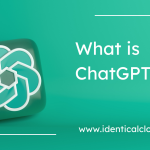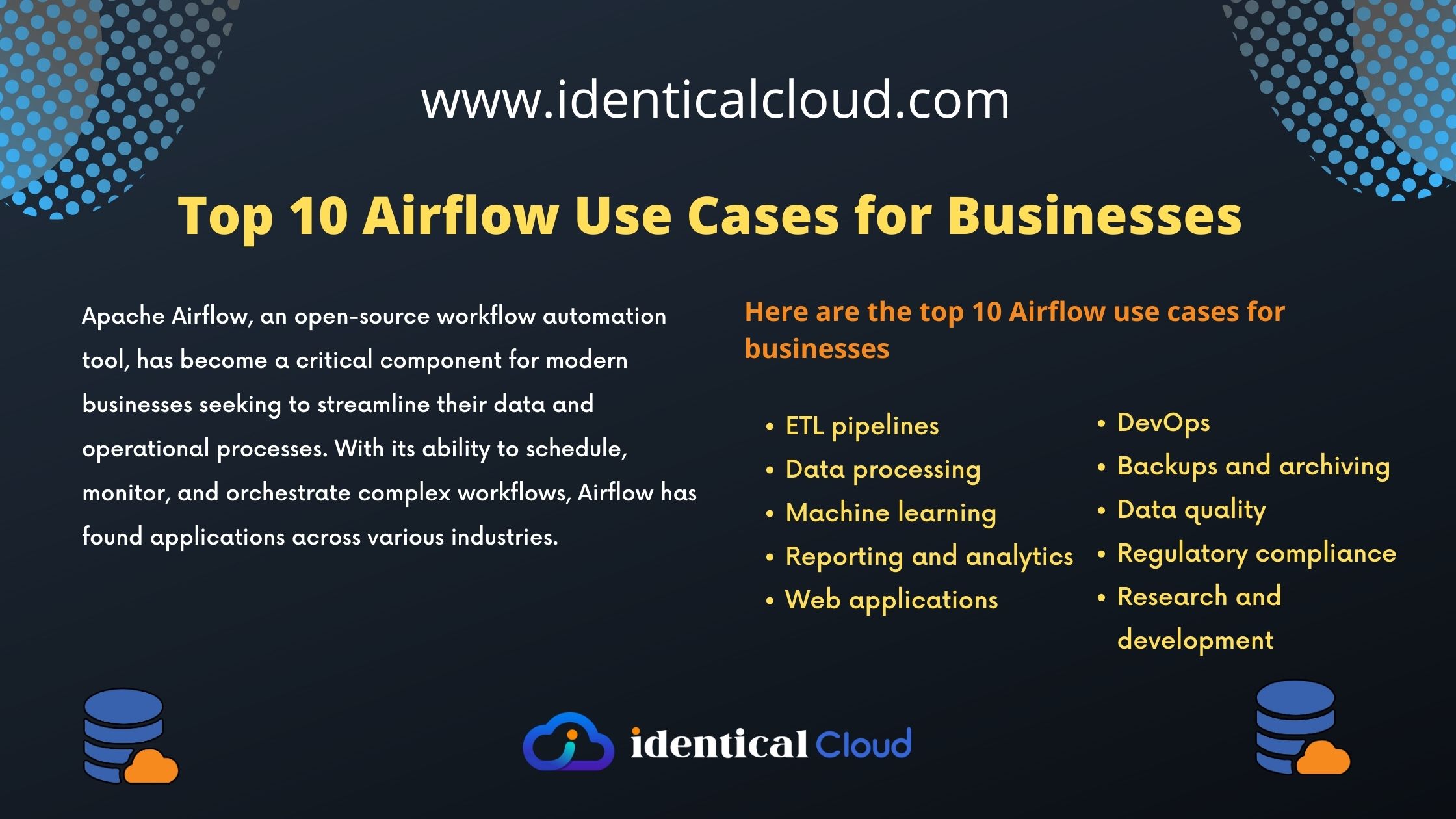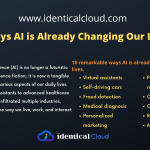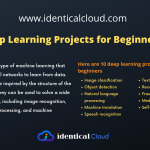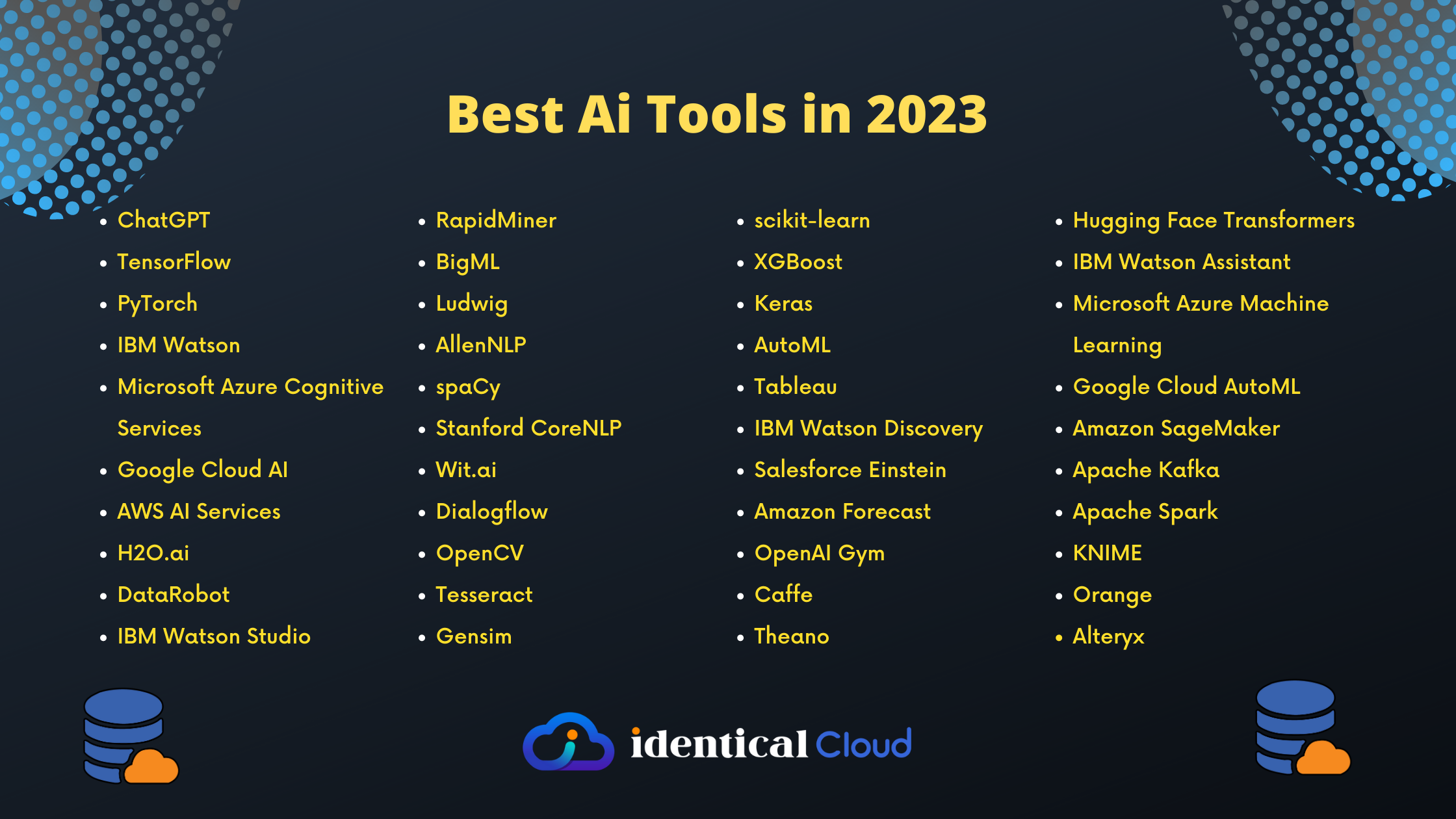
50 Best Ai Tools
Best Ai Tools in 2023
Artificial intelligence (AI) is rapidly changing the way we live and work. AI tools are now being used for a wide variety of tasks, from generating creative content to automating complex workflows.
In this article, we will explore some of the best AI tools available today. We will discuss their features, benefits, and drawbacks. We will also provide some tips on how to choose the right AI tool for your needs.
Here are the 50 Best Ai Tools with basic information.
ChatGPT:
A powerful AI language model developed by OpenAI, capable of generating human-like text responses.
TensorFlow:
An open-source machine learning framework created by Google. It provides a flexible platform for building and deploying AI models.
PyTorch:
An open-source deep learning framework known for its dynamic computation graph and ease of use. It is widely used for research and production in the AI community.
IBM Watson:
IBM’s AI platform that offers various tools and services for natural language processing, machine learning, and data analysis.
Microsoft Azure Cognitive Services:
A collection of AI tools and APIs offered by Microsoft, including computer vision, speech recognition, and natural language processing capabilities.
Google Cloud AI:
Google’s suite of AI tools and services that provide pre-trained models, APIs, and infrastructure for machine learning and data analysis tasks.
Amazon Web Services (AWS) AI Services:
AWS offers a range of AI services, such as Amazon Rekognition for image and video analysis, Amazon Polly for text-to-speech conversion, and Amazon Comprehend for natural language processing.
H2O.ai:
An open-source machine learning platform that provides tools for building and deploying AI models. It offers capabilities for automated machine learning and model interpretability.
DataRobot:
A platform that automates the end-to-end process of building and deploying machine learning models. It simplifies the workflow and provides tools for feature engineering, model selection, and deployment.
IBM Watson Studio:
A cloud-based platform for data scientists that offers a collaborative environment for building, training, and deploying machine learning models.
RapidMiner:
A data science platform that provides a visual interface for building and deploying AI models. It offers a range of tools for data preparation, model training, and evaluation.
BigML:
A platform that offers automated machine learning capabilities, allowing users to build predictive models without extensive coding or data science expertise.
Ludwig:
An open-source deep learning framework developed by Uber. It simplifies the process of building and training deep learning models by providing a high-level API.
AllenNLP:
A library for natural language processing research, built on top of PyTorch. It provides a range of pre-built models and tools for training custom models.
spaCy:
A popular Python library for natural language processing tasks, including tokenization, named entity recognition, and part-of-speech tagging.
Stanford CoreNLP:
A suite of natural language processing tools developed by Stanford University. It offers capabilities for tokenization, parsing, sentiment analysis, and more.
Wit.ai:
A natural language processing platform that provides tools for building chatbots and voice assistants. It offers pre-trained models and a user-friendly interface for training custom models.
Dialogflow:
A Google-owned platform for building conversational AI agents, including chatbots and voice assistants. It provides tools for natural language understanding and context management.
OpenCV:
An open-source computer vision library that offers a wide range of tools and algorithms for image and video analysis.
Tesseract:
An OCR (Optical Character Recognition) engine developed by Google. It allows the extraction of text from images and scanned documents.
Gensim:
A Python library for topic modeling and document similarity analysis. It provides tools for training and using word embeddings.
scikit-learn:
A popular machine learning library in Python that offers a wide range of algorithms and tools for classification, regression, clustering, and more.
XGBoost:
An optimized gradient boosting library that provides high-performance implementations of gradient boosting algorithms.
Keras:
A high-level deep learning library that runs on top of TensorFlow or Theano. It offers an easy-to-use interface for building neural networks.
AutoML:
Automated machine learning tools, such as AutoML Tables by Google or H2O.ai’s AutoML, that aim to automate the process of model selection, hyperparameter tuning, and feature engineering.
Tableau:
A data visualization tool that offers AI-powered features, including automated insights and natural language queries.
IBM Watson Discovery:
A tool that enables businesses to extract insights from unstructured data, such as documents, articles, and web pages.
Salesforce Einstein:
Salesforce’s AI-powered platform that provides tools for sales, service, marketing, and commerce automation.
Amazon Forecast:
A fully managed service that uses machine learning to generate accurate time series forecasts.
OpenAI Gym:
A toolkit for developing and comparing reinforcement learning algorithms. It provides a collection of environments and evaluation metrics for reinforcement learning tasks.
Caffe: A deep learning framework known for its speed and efficiency. It is commonly used for computer vision tasks.
Theano: An open-source deep learning library that focuses on efficiency and optimization. It provides tools for building and training neural networks.
Hugging Face Transformers:
A library that offers state-of-the-art pre-trained models for natural language processing tasks, such as text classification, sentiment analysis, and question answering.
IBM Watson Assistant:
A platform that allows businesses to build AI-powered chatbots and virtual assistants for customer service and support.
Microsoft Azure Machine Learning:
A cloud-based service that provides tools for building, deploying, and managing machine learning models.
Google Cloud AutoML:
A suite of tools that enables users to build custom machine learning models without extensive coding or data science expertise.
Amazon SageMaker:
A fully managed service that simplifies the process of building, training, and deploying machine learning models on Amazon Web Services.
Apache Kafka:
A distributed streaming platform that allows the processing and analysis of real-time data streams.
Apache Spark:
An open-source distributed computing system that provides tools for big data processing, machine learning, and graph analytics.
KNIME:
An open-source data analytics platform that offers a visual interface for building and deploying data pipelines and machine learning workflows.
Orange:
An open-source data mining and visualization tool that provides a user-friendly interface for exploratory data analysis and predictive modeling.
Alteryx:
A data preparation and analytics platform that offers tools for blending, cleaning, and transforming data.
IBM Watson Natural Language Understanding:
A tool that analyzes text to extract metadata and insights, including sentiment analysis, entity recognition, and keyword extraction.
Google Cloud Vision API:
A cloud-based API that provides image recognition and analysis capabilities, including label detection, face detection, and text recognition.
IBM Watson Visual Recognition:
A service that enables the analysis of images and videos using deep learning models for object recognition, scene detection, and image classification.
OpenAI Codex:
An AI model trained on code that can assist in programming tasks by providing code completion suggestions and generating code snippets.
Facebook Prophet:
A library for time series forecasting that offers automated model selection and forecasting capabilities.
RapidMiner:
A platform that provides tools for data preparation, machine learning, and predictive analytics. It offers a visual interface and a wide range of built-in algorithms.
BigDL:
An open-source deep learning library specifically designed for distributed computing using Apache Spark.
Google Cloud AutoML Tables:
A tool that simplifies the process of building and deploying custom machine learning models for tabular data without extensive coding knowledge.
These are just a few examples of AI tools available across various domains. The field of AI is rapidly evolving, and new tools and frameworks are continually being developed. It’s important to explore and evaluate different options based on your specific requirements and use cases.
AI tools are becoming increasingly powerful and versatile. They offer a wide range of possibilities for businesses and individuals. By choosing the right AI tool, you can automate tasks, improve your productivity, and create new opportunities.
We hope this article has helped you learn more about the best AI tools available today. If you have any questions, please feel free to leave a comment below.




